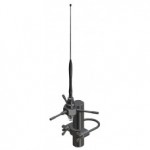Recently Uniden and Whistler announced scanners with capabilities of handling new digital formats. Each company has announced updates to their top-tier scanners and Whistler has also announced new models.
Here are some of the more frequently asked questions:
Q: What is DMR?
A: Digital Mobile Radio (DMR) is a digital format, similar in function to APCO P-25. It is mostly used by businesses but occasionally by public safety users. It is less expensive than P25 for the end user but it is not compatible with P-25 radios. It can be used in conventional or trunked modes.
Q: What is MotoTRBO?
A: It is Motorola’s implementation of DMR. They added a few features to the DMR standard and named it TRBO. DMR scanners can handle TRBO.
Q: What about encryption?
A: If the user selects the Encrypted mode then scanners cannot monitor it. There are no modifications or upgrades that can be made to get past radio encryption.
Q: What is Uniden offering?
A: Uniden has announced updates to its BCD436HP (handheld) and BCD536HP (desktop/mobile) scanners. One update is for ProVoice, a digital format used for some public safety purposes in parts of the country. They have also announced updates for DMR and MotoTRBO formats occasionally used by public safety but more often used by business users. Each of these updates are paid and ScannerMaster can install them for you.
Q: What is Whistler offering?
A: Whistler has announced updates for its WS1080 and WS1088 (handheld) and WS1095 and WS1098 (Desktop/mobile) scanners for DMR and MotoTRBO. These are free updates that are installed by updating the firmware in EZ-Scan. Again, ScannerMaster will be happy to install these for you as part of our Setup & Optimize service. No ProVoice upgrades have been announced for Whistler scanners.
In addition, Whistler has announced 2 new scanners. The TRX-1 (handheld) and TRX-2 (desktop/mobile) will work on DMR and MotoTRBO out of the box and will be updatable later for NXDN. (Expected about January 2017.)
Q: What about NXDN?
A: NXDN is a separate digital format used by some public safety agencies and businesses. It is slated to be used by the nations railroads once the required updates are made to the railroad’s infrastructure and radio fleet.
Whistler has already announced that NXDN will be available sometime in late 2016/early 2017 for its TRX-1 and TRX-2 scanners but will not be available for others. Uniden has not announced any NXDN updates yet but has said they are working on “other formats”.
Q: What about DMR trunking?
A: Both the Uniden and Whistler scanners will track DMR trunking systems.
Q: My question isn’t answered here. Where can I go for more information on these scanners or to buy them?
A: You can send your questions via email or call 1-800-SCANNER.

 Having a hard time receiving trunked and digital 700 and 800 MHz systems?
Having a hard time receiving trunked and digital 700 and 800 MHz systems?